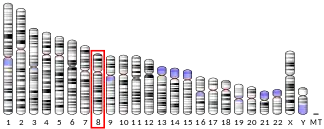| ADAM18 | |||||||||||||||||||||||||||||||||||||||||||||||||||
|---|---|---|---|---|---|---|---|---|---|---|---|---|---|---|---|---|---|---|---|---|---|---|---|---|---|---|---|---|---|---|---|---|---|---|---|---|---|---|---|---|---|---|---|---|---|---|---|---|---|---|---|
| Identifiers | |||||||||||||||||||||||||||||||||||||||||||||||||||
| Aliases | ADAM18, ADAM27, tMDCIII, ADAM metallopeptidase domain 18 | ||||||||||||||||||||||||||||||||||||||||||||||||||
| External IDs | MGI: 105986 HomoloGene: 74941 GeneCards: ADAM18 | ||||||||||||||||||||||||||||||||||||||||||||||||||
| |||||||||||||||||||||||||||||||||||||||||||||||||||
| |||||||||||||||||||||||||||||||||||||||||||||||||||
| |||||||||||||||||||||||||||||||||||||||||||||||||||
| |||||||||||||||||||||||||||||||||||||||||||||||||||
| |||||||||||||||||||||||||||||||||||||||||||||||||||
| Wikidata | |||||||||||||||||||||||||||||||||||||||||||||||||||
| |||||||||||||||||||||||||||||||||||||||||||||||||||
Disintegrin and metalloproteinase domain-containing protein 18 is an enzyme that in humans is encoded by the ADAM18 gene.[5][6]
This gene encodes a member of the ADAM (a disintegrin and metalloprotease domain) family. Members of this family are membrane-anchored proteins structurally related to snake venom disintegrins, and have been implicated in a variety of biologic processes involving cell-cell and cell-matrix interactions, including fertilization, muscle development, and neurogenesis. The protein encoded by this gene is a sperm surface protein.[6]
References
- 1 2 3 ENSG00000278548 GRCh38: Ensembl release 89: ENSG00000168619, ENSG00000278548 - Ensembl, May 2017
- 1 2 3 GRCm38: Ensembl release 89: ENSMUSG00000031552 - Ensembl, May 2017
- ↑ "Human PubMed Reference:". National Center for Biotechnology Information, U.S. National Library of Medicine.
- ↑ "Mouse PubMed Reference:". National Center for Biotechnology Information, U.S. National Library of Medicine.
- ↑ Frayne J, Hurd EA, Hall L (Aug 2002). "Human tMDC III: a sperm protein with a potential role in oocyte recognition". Mol Hum Reprod. 8 (9): 817–22. doi:10.1093/molehr/8.9.817. PMID 12200459.
- 1 2 "Entrez Gene: ADAM18 ADAM metallopeptidase domain 18".
Further reading
- Gerhard DS, Wagner L, Feingold EA, et al. (2004). "The status, quality, and expansion of the NIH full-length cDNA project: the Mammalian Gene Collection (MGC)". Genome Res. 14 (10B): 2121–7. doi:10.1101/gr.2596504. PMC 528928. PMID 15489334.
- Clark HF, Gurney AL, Abaya E, et al. (2003). "The secreted protein discovery initiative (SPDI), a large-scale effort to identify novel human secreted and transmembrane proteins: a bioinformatics assessment". Genome Res. 13 (10): 2265–70. doi:10.1101/gr.1293003. PMC 403697. PMID 12975309.
- Strausberg RL, Feingold EA, Grouse LH, et al. (2003). "Generation and initial analysis of more than 15,000 full-length human and mouse cDNA sequences". Proc. Natl. Acad. Sci. U.S.A. 99 (26): 16899–903. Bibcode:2002PNAS...9916899M. doi:10.1073/pnas.242603899. PMC 139241. PMID 12477932.
- Zhu GZ, Lin Y, Myles DG, Primakoff P (1999). "Identification of four novel ADAMs with potential roles in spermatogenesis and fertilization". Gene. 234 (2): 227–37. doi:10.1016/S0378-1119(99)00208-5. PMID 10395895.
- Frayne J, Jury JA, Barker HL, et al. (1998). "Macaque MDC family of proteins: sequence analysis, tissue distribution and processing in the male reproductive tract". Mol. Hum. Reprod. 4 (5): 429–37. doi:10.1093/molehr/4.5.429. PMID 9665629.
- Suzuki Y, Yoshitomo-Nakagawa K, Maruyama K, et al. (1997). "Construction and characterization of a full length-enriched and a 5'-end-enriched cDNA library". Gene. 200 (1–2): 149–56. doi:10.1016/S0378-1119(97)00411-3. PMID 9373149.
- Maruyama K, Sugano S (1994). "Oligo-capping: a simple method to replace the cap structure of eukaryotic mRNAs with oligoribonucleotides". Gene. 138 (1–2): 171–4. doi:10.1016/0378-1119(94)90802-8. PMID 8125298.
External links
- The MEROPS online database for peptidases and their inhibitors: M12.957
- Human ADAM18 genome location and ADAM18 gene details page in the UCSC Genome Browser.
This article is issued from Wikipedia. The text is licensed under Creative Commons - Attribution - Sharealike. Additional terms may apply for the media files.




